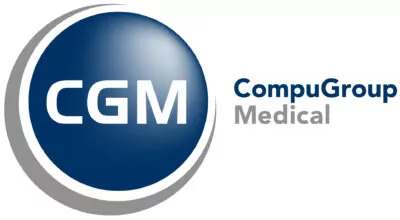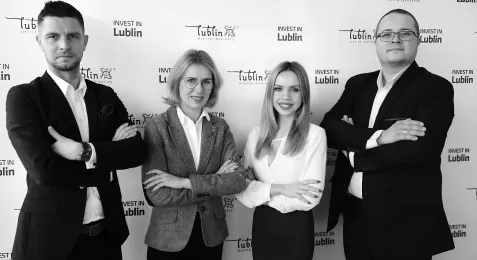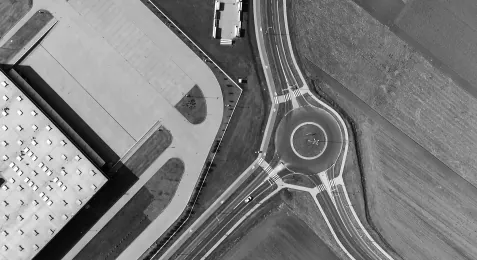Lublin Info Centre
CompuGroup Medical: Lublin’s leader in healthcare IT transformation

What were the beginnings of your company? How did the idea for this specific area of activity come about?
The company’s origins date back to the 1990s. An American company, Care LLC, wanted to implement the then-existing HIS (Hospital Information System) in Polish hospitals and found a company in Lublin that could support the implementation as well as translate the system into Polish. That’s how our story began. The company was then operating under the name UHC (University Health Care).
Since 2006, we’ve been part of the CompuGroup Medical holding, which operates internationally and is headquartered in Koblenz, Germany. This holding brings together entities exclusively focused on the digitalization of healthcare worldwide.
What technologies are you currently working on?
We specialize exclusively in medical informatics. Our flagship product is CGM CLININET, an HIS (Hospital Information System). You can compare an HIS to the bloodstream of a hospital – it’s the most critical IT system. The entire patient stay at the hospital is recorded in the HIS – from the moment of admission or outpatient visit registration until settlement with the National Health Fund (NFZ). Tests are ordered, medical documentation is created, prescriptions, referrals, and other documents are generated – all in our main system, CGM CLININET. It integrates with specialized solutions such as laboratory systems, allowing doctors to receive test results electronically immediately after they are performed.
Another highly important system produced by our company is CGM NETRAAD – a radiological system (RIS – Radiology Information System) fully integrated with CGM CLININET. Thanks to CGM NETRAAD, doctors can access diagnostic images in electronic form. The RIS system significantly improves the management of radiology departments and allows the storage and sharing of diagnostic images such as X-rays, CT, MRI, and ultrasounds in digital format. This system is where we started and from which we developed our subsequent products.
A few years ago, we expanded our healthcare offering with an ERP (Enterprise Resource Planning) system. This allows us to implement our solutions in departments such as human resources, accounting, and supply management.
All of our systems are integrated with each other, which automates processes and provides management with fast and comprehensive insights into the operation of these very complex “organisms.”
CGM Polska creates and implements its own products; we do not produce systems on demand. We are one of the few companies in the Polish market with such a broad offer for hospitals. We serve over 100 clients nationwide, including clinical, specialist, regional, and county hospitals. Our clients include: University Clinical Hospital No. 1 in Lublin, CRH Żagiel Med., University Clinical Center in Gdańsk, University Clinical Center of the Medical University of Warsaw, State Medical Institute of the Ministry of Internal Affairs and Administration in Warsaw, Memorial – Children’s Health Institute in Warsaw, National Institute of Cardiology in Warsaw, National Oncology Center in Warsaw, Polish Mother’s Health Center in Łódź, Oncology Center in Bydgoszcz, and the Provincial Specialist Children’s Hospital in Olsztyn.
We are proud not only of our wide offer and the high quality of our solutions but also of the relationships we build with our clients. Since 2018, we’ve been organizing regular CGM Connect meetings, where we meet with our clients, listen to their needs, and discuss new solutions based on their invaluable experience.
Relationships are also important within the company. For many specialists who have been working with us for years, CGM was their first job after graduation. This means they are very familiar with both the clients and the products. Most of our company’s managers have been here for over 15-20 years.
One example is our President, Waldemar Grudzień, who has been with the company practically since the beginning. He started as a programmer and then worked his way up through the company. Today’s position of our company in the market is largely thanks to his vision, ideas, and instincts, which directed the development of HIS systems in Poland. CGM CLININET was the first market system to operate in a web browser, which, at the time, was a bold and even revolutionary solution in medical informatics.
Are your solutions also being implemented in foreign markets?
Outside of Poland, we have primarily implemented imaging systems – radiology systems and systems dedicated to endoscopy. Some of our clients include Beaumont Hospital and St. Vincent’s University Hospital in Dublin (in both cases, the CGM ENDORAAD system was integrated with the hospital’s existing IT system), and the network of public hospitals under Health Service Executive (a solution realized within the framework of a government hospital computerization program, facilitating the exchange of medical data between facilities).
What is the current employment level at your company?
We employ about 250 people, the vast majority of whom are programmers, implementation consultants, customer support specialists, and analysts.
Do legal changes in healthcare require modifications to the HIS system?
Yes, legal changes are one of our priorities. For many years, medical entities have been settling accounts with the National Health Fund (NFZ) via IT tools – fully electronically. You could say we are responsible for the correctness and continuity of settlements. It’s worth noting that most of the largest and most complex NFZ contracts in Poland are settled through our system. The NFZ introduces changes very frequently, and we must regularly adjust to them.
For several years, we’ve also been in a phase of permanently implementing further solutions related to integrating hospital systems with central systems. Practically every patient in Poland has already used e-prescriptions, e-referrals, e-medical leaves, or Electronic Medical Documentation. The “life” of each of these documents begins in a system like ours. Of course, there are many more documents we handle that patients may not always be aware of. Our system is continually adapted to new requirements.
Which of your solutions were particularly important during the COVID-19 pandemic?
All HIS systems operate in accordance with the applicable legal regulations. The same was true during the pandemic when hospital operating rules were modified by the Ministry of Health, and changes were implemented ad hoc. When other sectors of the economy were shutting down, we, as a production company, had to work 24/7 to implement the changes resulting from the introduced regulations as quickly as possible into the HIS systems.
Another major challenge was organizing remote work for the implementation and support teams so that our clients felt the least impact of the change in the work format. The pandemic was a difficult time for all of us, but we demonstrated flexibility and showed that we can collaborate with our clients at the highest level, regardless of the situation.
Sometimes the changes pertain to NFZ settlements, other times to medical documentation management, and still others to the introduction of new so-called e-services that patients use. An example would be handling the EDM Integrator, i.e., electronic medical documentation, and P1 – the P1 platform. In every case, our system requires modification or updating. These tasks are a significant challenge for us and come with a great deal of responsibility. We are currently working intensively on integrating CGM CLININET with the Central e-Registration system, which will be accessible to every patient.
Could you tell us how many provinces in Poland currently have an integrated medical system?
For many years, healthcare entities have been implementing IT systems. Medical documentation is maintained, tests are ordered, and statistical data is reported to the NFZ within these systems. For years, these systems were isolated from each other. A patient referred, for example, from a clinic in Lubartów to a hospital in Lublin had to carry all of their medical documentation with them. Otherwise, the doctor would have no knowledge of their medical history. It was inconvenient and did not ensure the appropriate level of patient safety. Naturally, concepts of integrating IT systems operating in hospitals began to emerge, so that doctors could access a patient’s medical documentation produced in other facilities.
On the one hand, the state started building a central system aimed at integrating all systems in Poland, while on the other hand, projects for creating regional platforms began to appear. The first regional projects were implemented in the Podkarpackie and Podlaskie provinces, followed by other provinces implementing their own projects. These projects varied in size and scope. The largest regional project to date is being carried out by the Marshal’s Office of the Pomeranian Voivodeship. The outcome of this project will be the implementation of HIS, RIS, and ERP systems in several healthcare facilities and the creation of a regional platform integrating all systems. This platform will include several e-services dedicated to hospital staff (e.g., e-orders or e-coordinated care services), patients (e.g., e-registration, e-medical documentation, or e-information), and the provincial government (owner supervision). We are proud to say that the largest regional project in Poland is being realized by our company.
The direction in which healthcare in Poland is heading is central integration. The Ministry of Health is implementing projects aimed at central integration of all IT systems. The flagship product of the e-Health Center (CeZ), a government budgetary unit established by the Minister of Health, is the e-Health (P1) system. It forms the foundation of the digital ecosystem of medical services, collecting data on a patient’s treatment process, such as e-prescriptions, e-referrals, or visit histories. Patients have convenient and easy access to this information through their Internet Patient Account. All medical entities, regardless of the source of funding for their services, report to the system using platforms like our CGM CLININET.
You mentioned staffing earlier. What is the age range of employees at your company?
The largest group of employees at our company is between 30 and 40 years old. The management is slightly more experienced, with most managers having been with CGM since the beginning of their careers. The company has a very good, family-like atmosphere. We even have several married couples, and now the children of some of our more experienced employees are starting to work here as well.
Are your staff mostly graduates of Lublin universities?
The majority of them are graduates of Lublin universities, such as UMCS, Lublin University of Technology, or KUL. We also have employees from private institutions and graduates from other cities, especially now that some people are working remotely from various parts of Poland.
So, are these individuals mainly from IT-related fields?
Among the programmers, most have degrees in IT-related fields. However, in our testing teams, we’ve had, for instance, a lawyer and a person with a degree in administration. In teams responsible for system implementation or customer support, having an IT background is much less important.
I myself graduated in Cultural Studies from UMCS. So, I’m not a technical person, but my role at the company is related to product management – though not strictly from a technical perspective. I try to bridge the world of engineering with the world of business. I started as an implementation consultant, also working in customer support, and later managed projects, worked as a business analyst, and led teams. A cultural studies graduate, customer-oriented with a touch of technical thinking – I’m sure anyone like that will do well at CGM 😊
Do you use AI-related solutions in your systems?
Yes, artificial intelligence is increasingly being incorporated into our solutions. We try to leverage AI, for example, to support doctors in their work. We want AI to assist doctors in managing medical documentation or diagnosing patients.
Which companies do you consider your main competitors, and how do you navigate this competitive market?
Thanks to our experience, the technology we use, and our broad and comprehensive offering, our client base includes a large group of the biggest hospitals in Poland. Our system operates, among others, in hospitals with over 1,000 beds. The largest and most complex contracts with the National Health Fund (NFZ) are handled through our system. A very important element of our success is that we focus exclusively on medical informatics. For most of our competitors, it’s just one of many fields. We compete in the market with the largest Polish IT companies, such as Asseco or Comarch, but also with companies that focus primarily on the medical market, like Nexus Polska or Kamsoft.
In your opinion, as a resident of Lublin and a manager, what actions could support the development of new technologies in Lublin?
I believe that Lublin universities offer a very high level of education, and we certainly cannot complain about the competencies of the employees who come to us. What else could happen? Perhaps greater integration within the community and increased cooperation among companies that deal with topics similar to ours, as there are many such companies in Lublin.
Thank you for the conversation.
Thank you as well.






